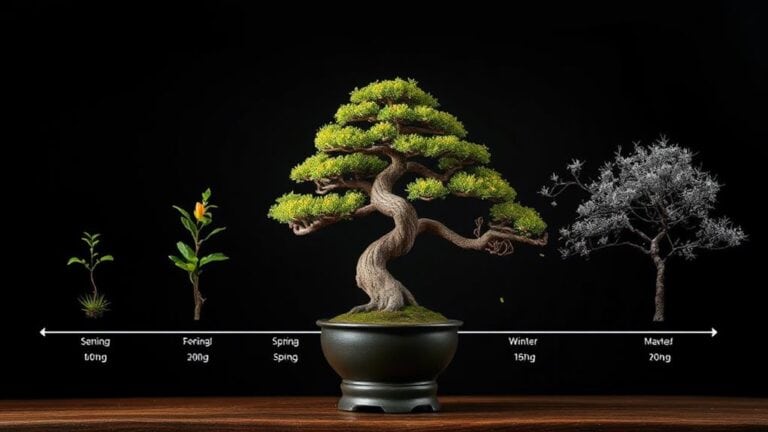Why Baby Hummingbirds Are So Hard To Spot
I've always found baby hummingbirds to be elusive, haven't you? Their tiny, featherless bodies blend seamlessly into their surroundings, thanks to nests made from leaves and spider silk. These nests are often high up in trees, out of reach from predators and prying eyes. The hatchlings remain perfectly still, relying on their mothers for warmth and food, which makes them even harder to spot. But there's more to their camouflage than just their nests and behavior. Curious about the other fascinating adaptations that help keep these little ones hidden? Let's explore further.
Mating Season Variations
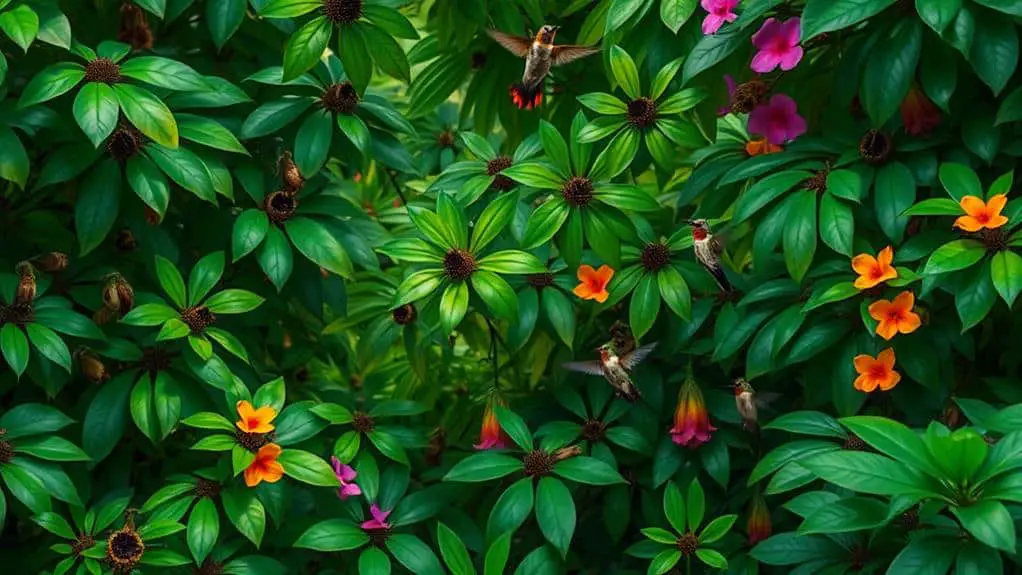
The mating season for hummingbirds is a fascinating dance that changes with the climate and region. Ruby-throated males return mid-March, with females arriving two weeks later.
During the breeding season, males establish and defend their territories, showcasing their non-monogamous behavior by mating with multiple females. This period can extend into July, allowing for multiple broods each year.
Understanding the timing of the mating season is essential if you want to spot these tiny birds. The males' early return guarantees they're ready to impress the females.
As the breeding season progresses, you might observe more activity. Females will be busy nesting and incubating their eggs, which hatch after 15 to 18 days. Keep an eye out, and you might just see them!
Limited Brood Size
Observing the lively antics of hummingbirds during their mating season, you might be surprised to learn that their reproductive efforts yield a surprisingly small number of offspring.
This limited brood size contributes to why baby hummingbirds are so hard to spot. Here's why:
- Brood Size: Female hummingbirds typically have 1 to 3 broods per year, with each brood consisting of 2 eggs.
- Simultaneous Hatching: Eggs are laid a day apart but hatch simultaneously, resulting in only a few chicks per cycle.
- Camouflaged Nests: The small, hidden nests make spotting these chicks even more challenging.
- Mother's Care: Hummingbird chicks are born naked and depend entirely on their mother, staying hidden for warmth and food.
These factors make baby hummingbirds quite elusive.
Hatching Duration
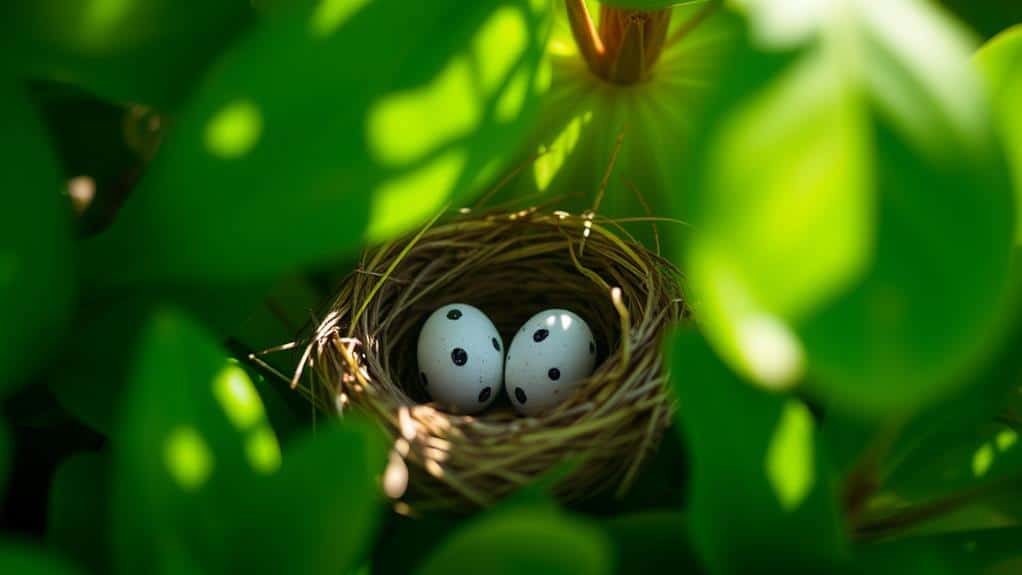
Waiting for baby hummingbirds to hatch always feels like an exercise in patience. The incubation period for hummingbird chicks ranges from 15 to 18 days. During this time, the mother maintains a cozy 96 degrees Fahrenheit to guarantee the eggs develop properly. Cold weather can delay the hatching by a few days, making the wait feel even longer. Curiously, although the eggs are laid one day apart, they hatch simultaneously, allowing the chicks to grow together.
The table below summarizes key points:
| Factor | Detail |
|---|---|
| Incubation Period | 15 to 18 days |
| Temperature Maintained | 96 degrees Fahrenheit |
| Weather Impact | Cold weather may cause delays |
The mother is solely responsible for this vital period, as males don't help with nesting or chick care.
Tiny Size of Babies
You'll be amazed by how tiny baby hummingbirds are when they hatch, measuring just about an inch long and weighing only 0.62 grams.
Their small size, along with being featherless, helps them blend perfectly into their nests, making them hard to spot.
These little ones are so well camouflaged that you mightn't even notice them, even if you're looking right at their nest.
Extremely Small Hatchlings
The sheer tininess of baby hummingbirds is truly astonishing.
These extremely small hatchlings are about 1 inch long and weigh just 0.62 grams. Their minuscule size makes them some of the hardest birds to spot.
To give you a clearer picture:
- Size: Baby hummingbirds measure around 1 inch in length.
- Weight: They weigh only about 0.62 grams.
- Eggs: Their eggs are the size of coffee beans.
- Featherless: Newly hatched chicks are featherless and depend on their mothers.
Because of their tiny size, baby hummingbirds can easily blend into their nests.
They're nearly invisible to both predators and observers. This makes these little birds a true marvel of nature, and their survival is a proof of their mother's care.
Camouflaged Nesting Sites
Often, the remarkable camouflage of hummingbird nests makes spotting them nearly impossible. Baby hummingbirds are born featherless and measure only about 1 inch in length. Their nests, also just 1 inch in diameter, are expertly camouflaged with leaves, moss, and lichens. This natural blend makes the nests almost invisible. The eggs, the size of navy beans, further add to the difficulty of spotting these tiny homes.
Here's a comparison to understand better:
| Feature | Size | Camouflage Materials |
|---|---|---|
| Baby Hummingbird | 1 inch | Featherless |
| Nest | 1 inch in diameter | Leaves, moss, lichens |
| Eggs | Size of navy beans | Natural surroundings |
| Nest Expansion | Flexible with growth | Spider silk |
| Visibility | Very low | Blends into surroundings |
As chicks grow, the nests expand but remain well-concealed.
Camouflaged Appearance
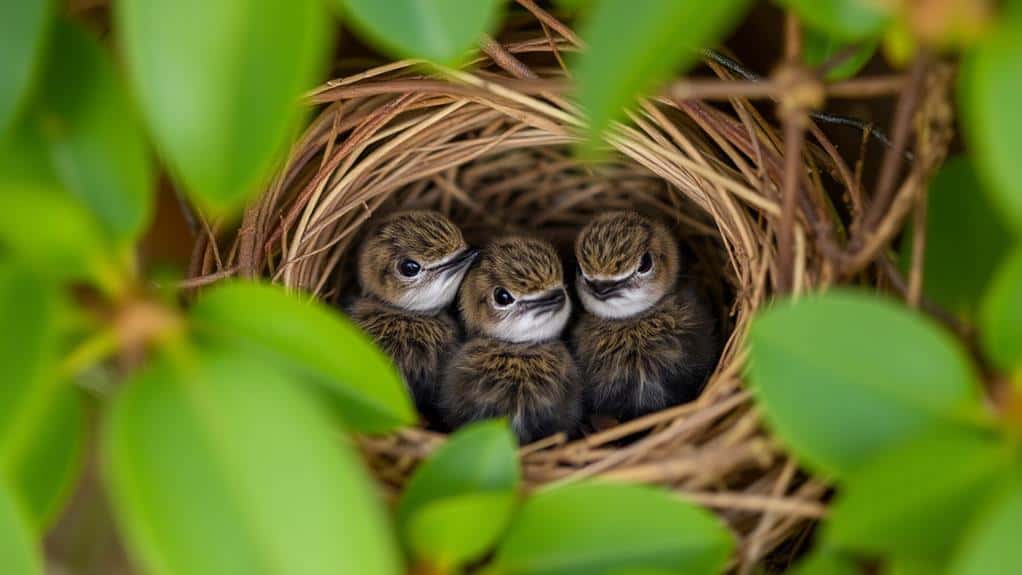
Baby hummingbirds are masters of camouflage, thanks to their featherless bodies and tiny size.
Their nests, often made with soft materials and covered in lichens, blend perfectly into the environment, making them hard to spot.
These little ones stay snug and hidden, their eyes closed for the first nine days, which further helps them avoid predators.
Natural Nest Concealment
Nestled among the foliage, hummingbird nests are marvels of natural engineering. They achieve natural nest concealment by using materials like leaves, twigs, and moss. This makes it tough to spot baby hummingbirds.
Here's why:
- Size: The nests are just 1 inch in diameter, perfectly hiding tiny hatchlings.
- Materials: Lichens and moss blend seamlessly with the surroundings.
- Hatchling Appearance: Newly born, featherless babies are nearly invisible.
- Placement: Nests are often built in dense foliage, adding another layer of camouflage.
These clever adaptations not only protect baby hummingbirds from predators but also make them nearly impossible to find.
Altricial Chick Characteristics
One might find it fascinating that baby hummingbirds are altricial, which means they're born naked and utterly helpless, depending entirely on their mothers for warmth and nourishment during their early days.
These tiny creatures, about an inch long and weighing only 0.62 grams, are incredibly hard to spot. Their nests are perfectly camouflaged, blending seamlessly into the environment.
With closed eyes for about nine days post-hatching, baby hummingbirds remain less visible, reducing the risk of predation. Though they might've a few yellow strands of down on their backs, their mostly featherless appearance helps them stay hidden.
This natural camouflage, combined with their small size, makes baby hummingbirds nearly invisible to potential threats, ensuring their survival.
Specialized Diet
Ensuring baby hummingbirds get the right nutrition is a fascinating process involving a diet that's specifically tailored to their developmental needs.
These tiny creatures rely on their mothers for a specialized diet, which includes regurgitated nectar and protein-rich insects like mosquitoes and gnats.
Here's a quick breakdown of their nutritional needs:
- Nectar: Mothers consume large amounts of nectar to provide energy.
- Insects: Protein from soft-bodied insects is essential for growth.
- Feeding Frequency: Chicks are fed approximately every 20 minutes.
- Malnutrition Risk: Without enough food, baby hummingbirds can suffer.
This specialized diet is crucial for their growth and feather development.
Flight Development

As baby hummingbirds hit the two-week mark, they start working on those all-important flight muscles and feathers, getting ready for their first flight. This stage, known as flight development, is essential. Around one month after hatching, these tiny fledglings will take their first independent flight. Initially, they strengthen their wings through exercises, critical for their survival.
Here's a snapshot of their progress:
| Age (Weeks) | Activity | Notes |
|---|---|---|
| 2 | Wing exercises | Building strength |
| 3 | Feather growth | Preparing for flight |
| 4 | First flight | Beginning independence |
| 5 | Ground practice | Refining flying skills |
| 6 | Maternal care | Learning foraging and navigation |
While they can fly, you might still spot them practicing. It's an exciting journey!
Hidden Nesting Habits
Have you ever wondered where baby hummingbirds come from?
Their nests are tiny, about 1 inch in diameter, and they blend seamlessly with leaves, twigs, and lichens, making them hard to find.
These small nests are often high up in trees like mulberry, willow, and cottonwood, so it takes a keen eye and a bit of patience to spot them.
Camouflaged Nest Locations
Hummingbird nests are marvels of natural engineering, expertly hidden high in the trees like mulberry, willow, and cottonwood, often between 10 to 90 feet off the ground.
These nests are camouflaged so well that they blend seamlessly with their surroundings. Female hummingbirds use natural materials like leaves, twigs, and lichens to create these hidden homes. They even use spider silk for added flexibility and insulation.
Here's why they're so hard to spot:
- Location: High in the trees, often in dense foliage.
- Size: Tiny, around 1 inch in diameter.
- Materials: Natural elements that blend in perfectly.
- New Nests: Each breeding cycle needs a new nest, making old ones hard to find.
Isn't that fascinating?
Tiny Nest Dimensions
Imagine stumbling upon a hummingbird nest; you'd likely miss it due to its minuscule size. Their tiny nest dimensions, about 1 inch in diameter, make them small and easily camouflaged. These nests blend into trees like mulberry, willow, and cottonwood, perched anywhere from 10 to 90 feet off the ground.
| Nest Feature | Description | Effect |
|---|---|---|
| Size | 1 inch diameter | Hard to see |
| Location | 10-90 feet high | Obscured |
| Materials | Leaves, twigs, spider silk | Blends in |
| Camouflage | Lichens, moss | Predator protection |
| Reuse | New each cycle | Hard to spot |
The female hummingbird guarantees her nest expands as the hatchlings grow, using flexible materials. This meticulous camouflage keeps baby hummingbirds well-hidden from predators.
Predator Avoidance
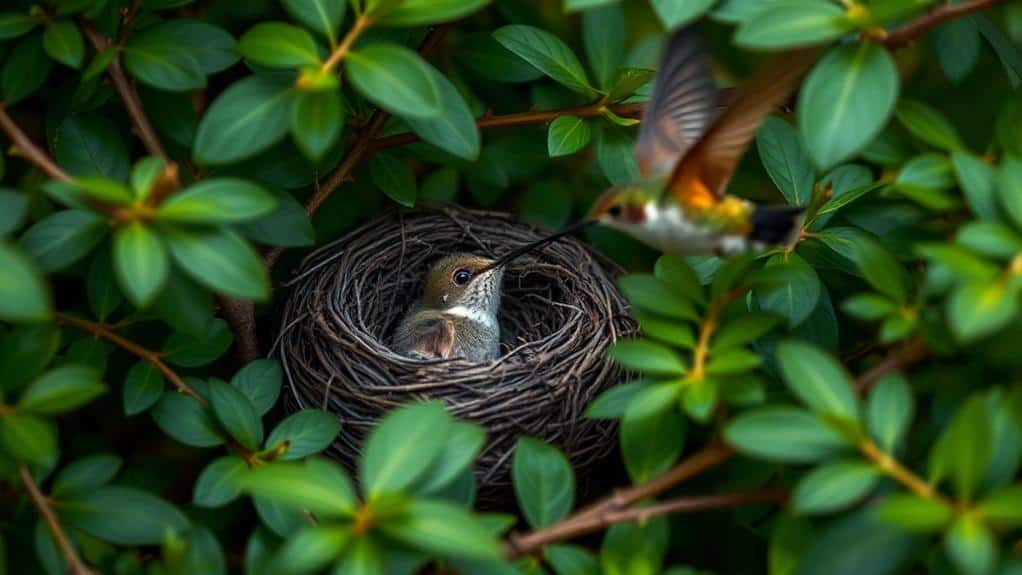
When it comes to predator avoidance, baby hummingbirds have some incredible strategies that help them stay safe.
These tiny birds utilize camouflage to blend seamlessly into their surroundings.
Here's how they do it:
- Featherless Hatchlings: Being born without feathers helps baby hummingbirds remain less noticeable in their nests.
- Nest Camouflage: Their nests are often constructed with lichens and plant materials, making them hard to spot.
- Motionless Behavior: Hatchlings stay perfectly still to avoid drawing attention.
- Elevated Nests: Female hummingbirds choose hidden, elevated locations for their nests, away from many predators.
Each of these strategies works together to keep baby hummingbirds safe, making them incredibly hard to spot in the wild.
Importance of Habitat
For baby hummingbirds, a well-preserved natural habitat is more than just a home; it's a lifeline.
They rely on trees and shrubs like mulberry, willow, and cottonwood for nesting. These plants provide both safety and essential resources.
Hummingbird nests are tiny and well-camouflaged, often made from leaves and spider silk, making them hard to spot and protecting them from predators.
Frequently Asked Questions
How to Spot a Baby Hummingbird?
To spot a baby hummingbird, I focus on their nesting behaviors and feeding habits. I watch the nest closely, especially during feeding times, using binoculars. The chicks' heads often pop up when their mother arrives with food.
Why Are Hummingbirds Hard to Find?
Hummingbirds are hard to find because their habitats are often dense with foliage. Their nesting behaviors involve creating tiny, camouflaged nests high off the ground, making them nearly invisible to predators and curious observers like us.
How to Tell a Baby Hummingbird From an Adult?
To tell a baby hummingbird from an adult, I look at size differences and feather development. Babies are tiny, about an inch long, and featherless, while adults are larger, fully feathered, and brightly colored.
Can You Touch Baby Hummingbirds?
You shouldn't touch baby hummingbirds. Handling them can cause stress and lead to abandonment. Baby bird care involves understanding hummingbird behavior. If you see one in distress, contact a wildlife rehabilitator instead of intervening yourself.
Conclusion
So, next time you're in your garden, remember that baby hummingbirds are masters of disguise. Their tiny size, camouflaged nests, and stillness make them nearly invisible. But don't worry! With patience and a keen eye, you might just spot one. Keep your garden welcoming with plenty of flowers and safe spots for nests. Enjoy the process and know that every little effort helps these incredible birds thrive. Happy bird-watching and gardening!







